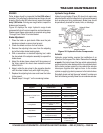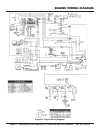
DCA25SSIU3 60 HZ GENERATOR • OPERATION AND PARTS MANUAL — REV. #0 (12/20/10) — PAGE 39
TRAILER MAINTENANCE
BRAKES
Trailer brakes should be inspected the fi rst 200 miles of
operation. This will allow the brake shoes and drums to seat
properly. After the fi rst 200 mile interval, inspect the brakes
every 3,000 miles. If driving over rough terrain, inspect the
brakes more frequently.
Figure 56 displays the major hydraulic surge brake
components that will require inspection and maintenance.
Please inspect these components as required using steps
1 through 8 and Table 15 as listed below:
Brake Adjustment
1. Place the trailer on jack stands. Make sure the jack
stands are placed on secure level ground.
2. Check the wheel and drum for free rotation.
3. Remove the adjusting hole cover from the adjusting
slot at the bottom brake backing plate.
4. With a screwdriver or standard adjusting tool, rotate
the star wheel of the adjuster assembly to expand the
brake shoes.
5. Adjust the brake shoes outward until the pressure of
the lining against the wheel drum makes the wheel
diffi cult to turn.
6. Adjust, rotate the star wheel in the opposite direction
until the wheel rotates freely with slight lining drag.
7. Replace the adjusting hole cover and lower the trailer
to the ground.
8. Repeat steps 1 through 7 on the remaining brakes.
Hydraulic Surge Brakes
Hydraulic surge brakes (Figure 56) should not require any
special attention with the exception of routine maintenance
such as shoe and lining replacement. Brake lines should
be periodically checked for cracks, kinks, or blockage.
Figure 56. Hydraulic Brake Components
Actuator
Hydraulic surge braking requires the installation of an
actuator at the tongue of the trailer. Remember the surge
or push of the trailer toward the tow vehicle automatically
synchronizes the trailer brakes with the tow vehicle brakes.
As the trailer pushes against the tow vehicle the actuator
telescopes together and applies force to the master
cylinder, supplying hydraulic pressure to the trailer brakes.
Periodically check and test the surge “actuator” to make sure
that it is functioning correctly. Never use an undersize actuator.
Table 15. Hydraulic Brake Troubleshooting
Symptom Possible Cause Solution
No Brakes Brake line broken or kinked? Repair or replace.
Weak Brakes or Brakes Pull to
One Side
Brake lining glazed? Reburnish or replace.
Trailer overloaded? Correct weight.
Brake drums scored or grooved? Machine or replace.
Tire pressure correct? Infl ate all tires equally.
Tires unmatched on the same axle? Match tires.
Locking Brakes
Brake components loose, bent or
broken?
Replace components.
Brake drums out-of-round? Replace.
Noisy Brakes
System lubricated? Lubricate.
Brake components correct? Replace and correct.
Dragging Brakes
Brake lining thickness incorrect or
not adjusted correctly?
Install new shoes and
linings.
Enough brake fl uid or correct fl uid?
Replace rubber parts
fi ll with dot 4 fl uid.


















